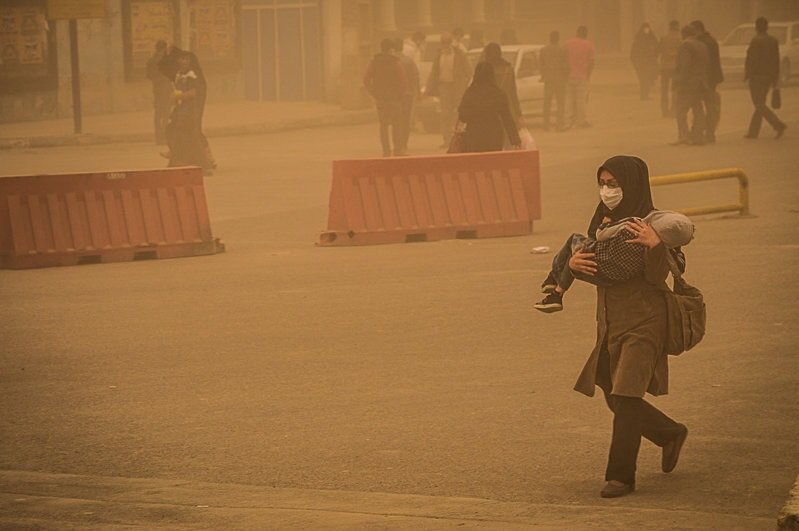Some €450m allocated to tackle SDSs in 3 years

TEHRAN – A total budget of €450 million has been earmarked to contain sand and dust storms (SDSs) nationwide over the past three years, deputy head of the Department of Environment (DOE) for the human environment has stated.
Eliminating SDSs hotspots has always been a concern of the government and the DOE, Masoud Tajrishi said.
Accordingly, in 2017, a special working group called "national headquarters for SDSs control" was formed, which has been able to manage this issue to a very good extent, he further highlighted.
Tajrishi went on to state that the headquarters first identified internal and external dust hotspots, based on which it was determined that about 35 million hectares are generating dust in the country, two million hectares of which are in critical condition.
Studies have shown that 40 percent of the critical dust sources are dried wetlands. To manage this section, we are going to have a meeting with the Ministry of Energy, he added.
About 350 million hectares of surrounding countries affect Iran, which is mainly raised from Iraq, Syria, Saudi Arabia, Afghanistan, the United Arab Emirates, Oman, and Turkmenistan, he noted, adding, so that the Ministry of Foreign affairs started negotiations with the international community to tackle the problem.
In order to manage external SDSs sources, we have many bilateral and trilateral agreements with countries such as Iraq and Syria, last week, we have reached good agreements with the United Nations in this regard, he explained.
Over the past three years, some €450 million have been spent to mitigate SDS hotspots in the country, Tajrishi said.
During this period, about 110,000 hectares undergone seedling plantation, more than 750,000 hectares of protection, trapping and grazing operations in pastures with dust-raising potential, soil stabilization in 150,000 hectares, including mulching, construction of live and non-living windbreaks, equipping 100 stations for forecasting and warning, about 360 thousand cubic meters of dredging operations, improving routes for water to reach wetlands and about 100 kilometers of water transmission channels to humidify areas with dust potential in 27 dusty provinces were among the actions have been taken, he explained.
Since the past few years, southern and western provinces of the country are frequently hit by sand and dust storms, as well as drought and even destructive floods, which are caused by both internal and external hotpots. Major external SDSs sources are Syria, Saudi Arabia, and Iraq.
In fact, Iran has been repeatedly exposed to SDSs due to its presence in the arid and semi-arid part of the world, so that in 2006-2007, the dust storms originating in Iraq and Syria affected Iran, haunting a wide area of the country so that it reached the central areas and southern slopes of Alborz and also included Tehran.
Consumption, changing the pattern of cultivation, and climate change have increased the negative effects of this phenomenon.
According to the World Metrological Organization, sand and dust storms usually occur when strong winds lift large amounts of sand and dust from bare, dry soils into the atmosphere. Over the last decade, scientists have come to realize the impacts on climate, human health, the environment, and many socio-economic sectors.
How to mitigate the effects of SDSs
According to EcoMENA, sand and dust storms cause significant negative impacts on society, economy, and environment at local, regional, and global scales. There are three key factors responsible for the generation of sand and dust storms – strong wind, lack of vegetation, and absence of rainfall. The environmental and health hazards of such storms cannot be reduced permanently, however, their impact can be reduced by taking appropriate measures.
As the dust cloud rises, it reduces horizontal visibility which can impact human life in many ways. The fine suspended particles also contain contaminants, bacteria, pollens, which cause negative health impacts such as allergies and respiratory diseases. Dust also carries airborne pollutants such as toxins, heavy metals, salt, sulfur, pesticides, etc. which cause significant health impacts when people inhale the contaminated dust. Dust can corrode buildings and other built infrastructure as it contains a high level of salts.
The effects of sand and dust storms can be reduced by using a number of health and safety measures and environmental control strategies. Large-scale sand and dust storms are generally natural phenomena and it may not be always practicable to prevent it from happening. However, control measures can be taken to reduce their impacts. Localized small-scale dust emission due to human-induced activities can be reduced by using temporary mechanical methods such as concrete barrier, mulching, tree buffer, etc.
Taking appropriate control of dust-raising factors such as increasing the vegetation cover where possible can help in the stabilization of the soil, sand dunes, and form windbreaks. Additionally, the use of native plants and trees as the buffer can reduce wind velocity, and sand drifts at the same increase the soil moisture. Designing buildings appropriately and conduct air infiltration testing during building commissioning can also help the adverse effects of sand and dust storm.
FB/MG
Leave a Comment